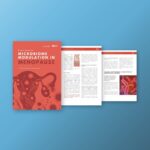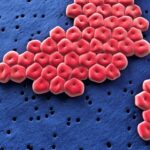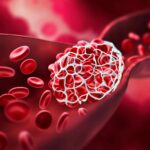In early life, the enrichment of certain microbes is essential for developing the pancreatic β-cell. In particular, a microbiota-mediated macrophage-dependent mechanism that recognises cell wall stimuli from commensal yeasts, like Candida, may be used to prevent or reverse β-cell loss, decreasing the incidence of diabetes.
This study, published in Science, highlights a new host-microbe signalling pathway that supports insulin production.
Since birth, our microbiota follows different phases, each dominated by certain microbial taxa. Acquiring the correct set of microbes is fundamental to guarantee lifelong health. For example, a loss of early-life microbial diversity is correlated with diabetes. However, the impact of microbes on pancreatic development and function remains unclear.
Macrophages play an important role in tissue development. Most of our understanding of pancreatic islet macrophages is based on adult models, leaving scarce knowledge about their influence in the neonatal period, the focus of this study.
Postnatal microbiota’s impact on β-cell development and function
In mouse models, the proliferation of β-cells peaks within two weeks after birth. After that, a dormant state starts making the readjustments, if needed, more challenging in adulthood. Germ-free models (GF) had shown a reduction in the β-cells counts compared to the models with a normal microbiota. This suggests the role of gut microbiota in the β-cells proliferation.
Not only that. Early life microbiota, including human ones, is constantly reshaping. Indeed, bacterial and fungal diversity increases in the postnatal window. For example, Candida was found in 12-week-old mice but barely in 20-week-old ones, while in kids, Candida dubliniensis has been shown to promote β-cells development.
Hence, a disequilibrium in the postnatal microbiota impacts β-cell development. In particular, neonatal exposure to antibiotics in mouse models:
- Had lasting consequences with a persistent defect in the β-cells count if exposed to broad-spectrum antibiotics. However, different treatments resulted in significant differences in β-cell amount, basal blood glucose, and insulin levels, suggesting distinct taxa are responsible for their neonatal expansion
- The β-lactam antibiotics had the largest effect. Among these, moxalactam uniquely enriched Bacilli in the remaining microbiota.
- The production of insulin did not always correlate with the glycaemic response, suggesting multiple microbial interferences
- Overall, the fasted blood glucose increased with a parallel reduction in glucose tolerance, fasting serum insulin, and insulin secretion in response to glucose
- Human faecal samples from children (4 to 30 months of age) were used to colonise GF pups. The recipients of children between 7 and 12 months of age had significantly more insulin-expressing tissue and serum insulin than mice colonised from any other age group
- Models treated with moxalactam had significantly increased β-cell count compared with GF controls, showing also normal glycaemia, and elevated serum insulin levels
- Moxalactam-treated and specific-pathogen-free (SPF) mice showed a different bacterial abundance distribution, Enterococcus in particular
- Candida spp. DNA levels varied based on the antibiotic treatment, showing an enrichment in moxalactam-treated animals compared with SPF mice
- Pups treated with moxalactam alone had high β-cell count. Instead, the co-treatment with fluconazole induced a significant decrease, indicating the role of fungi in the β-cells proliferation. Indeed, while E. coli isolates had no stimulatory effect on islet proliferation, Candida dubliniensis had significantly increased β-cells compared to GF animals
How the microbiota influences the neonatal islet development
Macrophages are only a small minority of the total islet RNA, but they are the major immune cell type of islets under steady-state conditions. The microbiota has been shown to influence the seeding, not the phenotype, of islets’ macrophages. Indeed:
- The microbiota induced changes across the islet transcriptome. Biological processes important for responding to microbes, including fungal-associated response elements, were all increased in SPF islets compared with 20-week-old GF
- Differences also in the expression of transcripts associated with myeloid cells between SPF and GF samples. Among these, macrophage markers were significantly increased in 20-week-old SPF mice compared with GF mice
- The average number of macrophages per islet increased significantly from 10 to 20 weeks of age in SPF animals, indicating that islet-associated macrophages expand across early life in response to the microbiota
- Even if the microbiota promotes macrophage proliferation in neonatal islets development, it has a minor impact on their inflammatory state
Macrophages are important for increasing postnatal β-cell mass
Researchers wanted to verify whether macrophages are essential for the neonatal β-cell expansion. To do this, they depleted the systemic tissue-resident macrophages and reduced the circulating ones in SPF and GF pups, noticing the following:
- The systemic loss of macrophages induced a tissue reduction, including a smaller pancreas mass. Those models also showed a lower insulin-producing tissue and basal values compared to control mice. However, GF mice presented a similar β-cell mass and insulin levels to those with depletion of macrophages, suggesting a microbiota-dependent effect
- The macrophage depletion resulted in an enrichment of proinflammatory signalling
- Islet macrophages secrete growth factors that stimulate β-cell proliferation
- The depletion of macrophages in early life has long-lasting effects. Indeed, adult SPF mice exposed to macrophage depletion during the neonatal period had trending reductions in β-cell mass coupled to a significant reduction in fasting serum insulin, glucose tolerance, and insulin secretion
- Candida dubliniensis requires macrophages to induce host beta cell expansion, while other microbes are independent of macrophages, suggesting how the diversity of host-microbe interactions affects insulin-expressing tissue development
Candida cell walls and host β-cells phenotypes
Candida albicans and C. dubliniensis are very similar, with only a few differences in cell wall composition and hyphae formation. Despite these minor changes, host immune regulation was shown to respond uniquely. To test whether C. albicans‘ negative effects on β-cell development could be attributed to increased filaments, mice were exposed to a strain of C. albicans unable to form hyphae, showing no increase in β-cell mass. Therefore, the loss of hyphae is not enough to rescue host β-cell development. However, when mice were treated with a mutant of C. albicans that had lost the expression of the transcription factor Ahr1 (which has a prominent role in regulating Candida cell wall composition), the β-cell mass increased significantly.
In the case of C. dubliniensis, the effect on the β-cells varied based on the strain. For example, the wild-type strain of Wü284 induced a significant increase in the levels of mannan and chitin with consequent reduction in β-cell mass. Meanwhile, a Wü284 mutant, Dnrg1, with an increased hyphal formation, didn’t affect the β-cell mass.
So, Candida cell wall composition differs significantly between strains and is an important driver of β-cell mass.
C. dubliniensis can reduce diabetes incidence
The microbiota profile in early life is critical for regulating the onset of diabetes. In fact, in non-obese mouse models of type 1 diabetes, C. dubliniensis, a commensal fungus, can reduce diabetes incidence. Not only that. In adult GF mice, C. dubliniensis also promoted β-cell replacement after injury and antibiotic treatments, improving the survival rate and ability to clear blood glucose.
To summarise
This study highlights a crucial period in early life when particular microbes are required to sustain the development of pancreatic β-cells. Fungi and bacteria play a fundamental role in insulin regulation, but the impact on the host varies based on their origins and features. The findings pinpoint a macrophage-dependent, microbiota-mediated mechanism that facilitates the recognition of unique commensal yeast cell wall stimuli, which could be employed as a strategy to stop or reverse β-cell loss.











